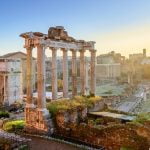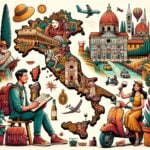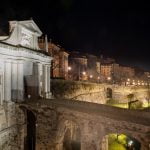
The ancient history of Italy is one chock-full with some of the most influential figures, artwork, and architecture in world history. From Etruscan rulers to Roman emperors, from Renaissance artists to Baroque sculptors, from opulent palaces to historic churches, the ancient architecture and culture of Italy has been of a crucial influence on the development of western civilization over thousands of years.
It is this rich legacy that defines the country today and has established it as one of the most culturally significant nations in Europe.
The roots for this cultural hub date back to about 1000 BC, when numerous different peoples began inhabiting separate regions what is now modern day Italy. Early settlements in cities like Rome, Florence, Milan and Venice helped create a stronghold for new cultures to thrive within Italian soil.
Most famously were the Etruscans who settled in large inland settlements including their capital at Tarquinia around 800 BC. The Etruscans are revered for having set many iconic practices and institutions that served as educational frameworks for both Roman Republics and Empires that would come forth in subsequent centuries.
Though highly influential during its time, much more is remembered about Ancient Romans than Etruscan in modern times thanks largely in part to their sheer power across not only all of Italy but throughout much of Europe as well during periods such as the reigns of Augustus Caesar (27 BC – 14 AD) and his adoptive son Tiberius (14 – 37 AD).
This powerful expansion brought forth innumerable architectural projects designed by famous architects like Vitruvius culminating eventually in structures such as The Colosseum, Pantheon and Trajan’s Market which still define urban landscapes across Rome to this day.
Influences stemming from those eras can also be found throughout countless architectures ranging from apartments to public buildings even seen from London to New York City today that have long lasting cultural relevance due largely in part to Ancient Roman teachings taught over millennia ago.
The contributions made by Ancient Italians remain ever present no matter where you look around today’s modern world whether it be through culinary affects or fine arts innovations signaling an immense impact that continues resonating throughout various mediums right up until current times making its ancient history one that’s cannot be forgotten any soon anytime soon.
Ancient Tribes of Italy
Ancient history of Italy is heavily intertwined with the influence of its many tribal groups. These ancient tribes played an integral role in shaping what later became modern-day Italy. Their lifestyles, language, warfare styles and religion all helped to shape this region into what it is today.
Etruscans: From The North
The first known inhabitants and most influential people in Italian history were the Etruscans. They built a powerful civilization that would last nearly 500 years centered around Rome and extending down eventually all the way down to Naples. They developed their intricate system of writing before the Romans and had trades ranging from bronze work to stoneworking. The Etruscan pantheon was diverse and included many gods as well as a figure of a Supreme God Primitive or Priests King.
Sabines: Warlords Of Central Italy
Another influential tribe were the Sabines who dominated much of central Italy for centuries. Their military skills were legendary which led them to prove themselves throughout multiple wars.
The Sabines believed in many gods and goddesses such as Jupiter, Neptune, Mars, Apollo, Diana, Minerva, Mercury and Juno among others but also had their own more localized cults referred to already by Latin poets like Virgil or Propertius during Augustus’ time (27 BC-14 AD). Their influence can still be seen today in locations such as Tivoli and Palestrina where their old ruins remain standing as symbols of their strength over time.
Umbrians: Mountain Dwellers Of The East
The Umbrians are perhaps one of the oldest tribes inhabiting central Italy predating even the aforementioned Sabine tribe by numerous centuries. They hailed from the region now known as Umbria, located in eastern Italy between Tuscany and Marche along both banks of river Tiber.
Unlike other tribes known for their ferociousness in warring such as the Gauls or Samnites; historians consider them well-mannered folk that avoided confrontation wherever possible instead forming alliances with neighboring groups at times for mutual benefit. Also unique amongst ancient Italian tribes they possessed their own language derived from Indo-European originating two thousand plus years ago – though unfortunately only limited fragments survive up until present day.
The Rise of Rome
The ancient city of Rome is an impressive and mysterious symbol of power from the distant past. The rise of Rome is inextricably intertwined with the mythologies, religions, monuments, and structures that are still visible today.
This ancient capital of Italy has a complex history, beginning when it was founded in 753 BC by two brothers Romulus and Remus. From then until its fall under Constantine I’s rule in 476 AD, it experienced numerous transformations as it changed through various political phases.
At its foundation, Rome began as part of a small community under the control of Etruscans. As the city grew and expanded over time, its governance shifted among groups such as the Latin kings which contributed to its increasing political prowess. Eventually the Roman Republic established itself as a significant power that controlled vast territories.
It was during this period that many iconic sites and artifacts were constructed or commissioned, such as Julius Caesar’s resplendent Forum Romanum which still stands today only slightly less breathtaking than its former glory. In addition to their building, the Republic’s early years saw great successes in war with battles like Hannibal’s defeat at Zama leading to increased unity and support amongst much of Italy’s peoples for Rome’s rule.
This success encouraged further innovation and investment into infrastructure such as aquaducts and other public works designed to make life easier for Roman citizens while also demonstrating their might at constructing grandiose projects during the zenith of their power under Augustus Caesar who became emperor after wresting control from powerful senators such as Cicero Mark Antony & Octavian in 31BCE.
After his death Augustus’ legacy lived on throughout several centuries more emperors who oversaw robust armies that conquered more lands including large parts of Europe Britain North Africa Middle East Asia Minor & Mesopotamia all while managing efficient agricultural systems to feed these growing populations creating some of earliest foundations our modern bureaucracy & politics.
The influence left by the Ancient Romans can still be felt even now with modern language architecture culture art politics being indelibly shaped by time they spent ruling Italian peninsula what started out small city-state eventually became most powerful empires ever known Western Civilization will continue be inspired by Roma Aeterna – Eternal City forever.
Barbarian Invasions
The term Barbarian is often applied to anyone outside of a particular culture or civilisation. During the late Roman Empire, this term was often associated with several nomadic tribes that moved in and out of Europe. The most impactful of these Barbarians within Italy were the Visigoths, Ostrogoths, Vandals and Lombards. Each tribe had a distinct history and contributed to Italy’s overall diverse culture.
The Visigoths were the first group to appear in Italy, entering in 410 CE while crossing the Alps on their way from Augustine’s Roman army towards Gaul. They would remain in parts of northern Italy until 476 CE when Odoacer would crown himself King of Italy and expel them from power.
Despite their brief time ruling over Italy, they had a lasting effect by introducing various aspects of Rome Law such as allowing women to become property or slaves freely, and abolishing ancient forms taxation.
The Ostrogoths arrived on Italian soil much later than the Visigoths did, crossing into northeastern Italy during 568CE soon after Emperor Justinian I expelled them from present-day Russia due to political tensions back home. Much like their predecessors, they began to establish their rule among the Italian people by introducing East Germanic laws and decrees which at times included aspects such as forcefully collecting gold coins as part of taxation systems.
Unlike the Visigoths however, they reigned for longer in 540 years before being finally overruled by Byzantine Emperor Gregorio II during 603CE.
The Cultural Impact Left Behind
It is important to note that despite their violent nature or imposed rule over Italy for nearly 1200 years combined; they all left essential cultural impacts on its heritage:
- Latin Language: Due to constant interaction between Barbarians with former Roman citizens/slaves – Latin became widespread language across regions including areas now known as France/Spain.
- Religion: Traditional Barbarian religions laid basis for weaving Catholic/Orthodox Christianity into present day Italian cultures.
- Trade: Wealthy amount of coastal harbors opened up for new exchange opportunities with emerging markets
- Cuisine: Mixtures between Barbarian cuisine/local produce formed bases for signature dishes.
- Architecture: Introduction Gothic Architecture style ultimately boosted development empires suchs Milan or Venice.
The Menace of the Middle Ages
Italy in the Middle Ages was significantly shaped by the emergence and resolution of feudalism. This system’s presence and prevalence had an indelible mark on key facets of history across the peninsula for centuries, leading to much distress amongst those who became a part of it.
The concept of feudalism was birthed as early as the 9th century, forming in the same manner that it had elsewhere – namely, the concession made by kings to local magnates in exchange for their protection or military service. The feudal relationship could take many forms – from vassalage to fiefdoms – but its end goal was similar: divide power amongst local aristocrats while still providing useful benefits to Kings or other ruling provincial elites.
Though initially beneficial, the system soon became oppressive due to inequality accepted among lords and subjects; this eventually led to mass poverty, migration, and widespread unrest.
From a societal standpoint, Italy during medieval times witnessed some of its most oppressive moments: rampant authoritarianism via corruption, subsistence-level living conditions for peasants due to heavy taxation, and unchecked violence towards those who didn’t obey one’s master.
To make matters worse, as Italy functioned under multiple governing bodies (dukes or lords typically ruled their own secluded domains), there were often clashes between them over land or resources which resulted in long-standing feuds that intensifified regular life struggles even further.
- Feudalism emerged in 9th century Italy.
- Divided power among local aristocrats while providing benefits to ruling elites.
- Rampant authoritarianism & unchecked violence.
- Heavy taxation & subsistence living conditions for peasants.
- Clashes between various governing bodies over land & resources.
The Resurgence of the Renaissance
The Renaissance period marked the beginnings of a cultural revival in Italy. This period was characterized by an embrace of classical topics such as philosophy, art, and literature. During this time, hundreds of new universities were established and newly discovered ancient texts provided scholars with access to forgotten works. From the 14th to 17th centuries, Italian cities such as Florence and Venice became hubs of creativity and intellectual life.
The Printing Press Revolutionizing Education
A major factor contributing to the newfound exploration of classical works during this era was the invention of the printing press in 1440 by Johannes Gutenberg. For centuries before, books had been carefully copied by hand but this new technology allowed for multiple mass copies to be made quickly and easily.
This led to an explosion of printed knowledge that was spread across Europe at rapid speeds. Information from ancient Greek philosophers was now incredibly accessible both inside and outside Italy.
Investment in Humanities Education
As a result of these new found sources of knowledge, humanities education suddenly boomed throughout Italy. Ancient texts like Plato’s Republic were now required parts of university curriculums and thinkers like Galileo Galilei revolutionized scientific understanding through his studies on physics and astronomy. In addition, prominent religious figures such as Thomas Aquinas made significant contributions to scholasticism which further framed education around discovering truths about society through reason rather than revelation alone.
Bringing Forth renewed Philosophy
Beyond education itself, famous humanists also began to implement their discoveries into personal philosophies that could inform public policies or influence both moral thinking or artistic endeavors within literature or music composition during this period known as early modernity (following late antiquity).
Notable figures like Michelangelo gave visual expression to ideas never seen before while Niccoló Machiavelli wrote political treatises that offered insights on how governments should be run properly using practical approaches instead of moral fables or examples from the Bible only.
All these advancements made during the Renaissance were instrumental in transitioning Europe from a medieval mindset into one that welcomed premises understood today as rationalism, humanism, empiricism, secularization-and more-that still shape our thoughts today.
The Unification of Italy
Italy’s long history stretches back to the earliest days of human civilization. Ancient Rome, which was a huge political and cultural center in its time, was the predecessor to the unified Italian nation we know today. This article will focus on exploring the factors that led to the unification of modern Italy in 1861.
The Rise of Modern Italy
Beginning around 1800 a number of independent states formed in different parts of Europe including France, Belgium and others. At this same time a number of different states were forming in Northern Italy including Sardinia, Piedmont, Genoa, Milan, Tuscany and Lombardy. All of these states had their own governments and laws but there was no single unified nation like there is today.
The Political Unification
In 1815 Vittorio Emanuele (also known as Victor Emmanuel) was declared king of Piedmont-Sardinia which at the time was one of the largest independent states in Northern Italy. He then sought to bring together all of the northern Italian states into one big unified kingdom.
In his efforts he faced many oppositions from both inside his court as well as some outside forces such as Austria who wished to maintain control over some Italian territories.
Nevertheless, Vittorio persevered and by 1860 most independent Italian regions had joined Vittorio’s kingdom during wars or through diplomatic agreements with rulers of other states who saw it beneficial for them to be part of a much larger Italian kingdom instead or being ruled by their neighbors or by other foreign powers.
The Role Of Giuseppe Garibaldi
Finally, after years of struggle for unification one important leader emerged that would lead to a final unification: Giuseppe Garibaldi. He played an important role during wars fought against Austria and also during diplomatic negotiations with other small neighboring countries that wanted to join Vittorio’s enlarged kingdom willingly rather than fight with him.
After a long series of battles; Garibaldi eventually succeeded in uniting all northern Italy under Vittorio’s rule and thus creating a unified nation called “Italy” in 1861 which would eventually become what is known as modern day Italy today by joining southern regions such as Sicily under its flag later on in 1863-4.
Impact and Legacy
The ancient history of Italy has made a huge impact on the world today. It has inspired and influenced arts, culture, politics, philosophy, science, and literature. This is exemplified by some of the most famous Italian contributions to society throughout history – from the art of Michelangelo to the political works of Machiavelli. Ancient Rome, in particular, was a major source of influence due to its vast and powerful empire.
One legacy that is still very evident today are the Roman laws and judicial system which form the basis for many legal systems around the globe – including in Europe, North America, and Latin America. Roman architecture also had strong influence over many global styles with its iconic arches and columns found popularly throughout public spaces such as town squares and government buildings.
Another prominent legacy from Ancient Italy that can still be felt today is classical Latin literature such as those written by Virgil, Ovid, Seneca and Cicero. These works have been studied for centuries including during key moments in Western Civilization such as the Renaissance period in fifteenth centry Florence when scholars like Petrarch re-emphasized Greek and Roman thinking in their literary works.
Additionally these classics have been translated into countless languages making them accessible to millions of people worldwide inspiring new generations of poets writers and thinkers across all cultures.
All these legacies make it clear that Ancient Italy continues to shape our world even today through values reflected in art literature politics science philosophy and other areas of societal life. The rich heritage left by Ancient Italians serves as a beacon to explore new clues about our past while at same time providing guidance on how better move forward towards a better tomorrow for all mankind.
Conclusion
Reflecting on the long and rich history of Italy, it is clear that it has had a considerable influence on world culture for centuries. While much of the iconic monuments, art, and architecture have been preserved since antiquity, much of this nation’s most important impact has been in its contribution to the foundation of European civilization.
Although there are likely more than one factor that contributed to the nation’s success in this regard, two often discussed are the Etruscan civilization and Ancient Roman Empire. The former was instrumental in developing social structures reliant upon trade within Italy and beyond its borders; they also left indelible legacies in language, religion, arts, and architecture.
Furthermore, as an expansion of Europe’s cultural boundaries were further pushed outward when Rome gained control over much of the Mediterranean region resulting in far-reaching political systems being established across multiple continents which would later evolve into governments comparable to our modern democracies today.
By taking a closer look at specific moments along Italy’s path through history from location settlements by prehistoric peoples thousands of years ago to major empires ruling for centuries and eventually creating a unified nation after centuries of division and turmoil – a distinct appreciation can be gained for how truly meaningful this places journey has been on shaping our current global landscape.
It is no surprise then that Italian art, figured prominently throughout generations from renown pioneers such as Michelangelo and Da Vinci down to modern day filmmakers like Fellini’s La Dolce Vita or Sorrentino’s La Grande Bellezza both rooted in deeply traditional values yet firmly looking ahead towards unparalleled progress.
This air of nostalgia combined with an unwavering optimism appears is very much a trademark feature that can be attributed back to Ancient History Of Italy which still survives today despite any shifts or changes facing it along the way.




